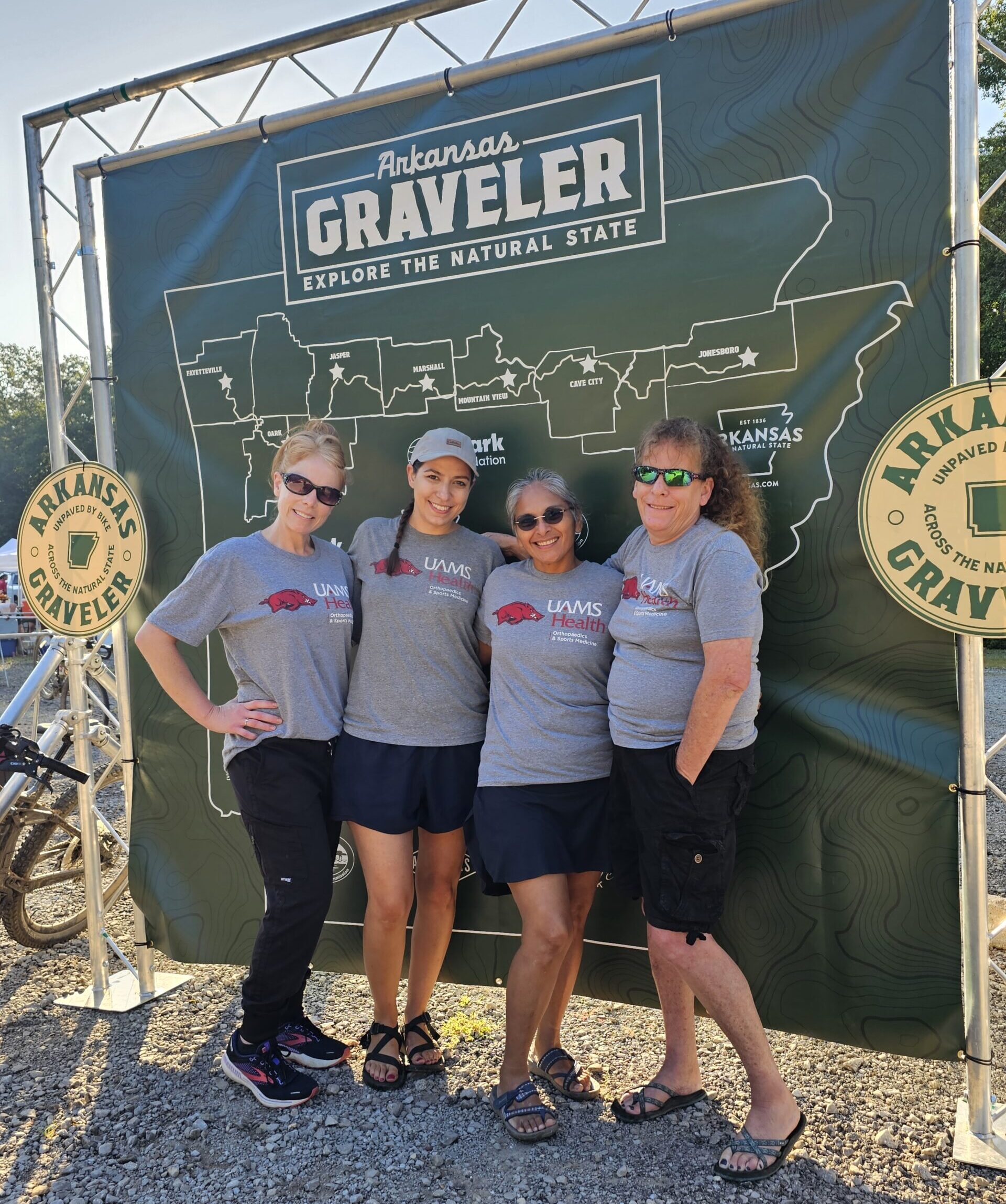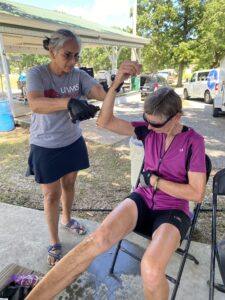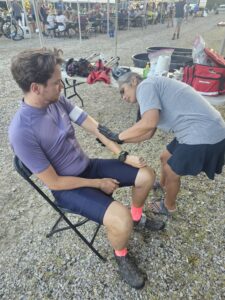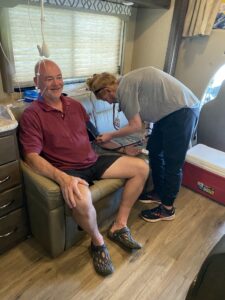UAMS Team Members Take to the Backroads to Provide Medical Support for Arkansas Graveler
| Six University of Arkansas for Medical Sciences (UAMS) team members recently spent a week traveling rural Arkansas backroads to provide medical coverage for the Ozark Foundation’s Arkansas Graveler event.
The Arkansas Graveler is a multiday, 350-mile gravel cycling festival that takes place across rural Arkansas. This year, it started in Fayetteville on a Sunday and ended in Jonesboro on a Friday. The UAMS Orthopaedics & Sports Medicine team had a full staff from Northwest Arkansas (and one person from The Orthopaedic & Spine Hospital at UAMS in Little Rock) going to every stop and sleeping in each campsite along the way to provide hydration and medical care.
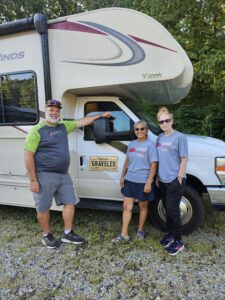
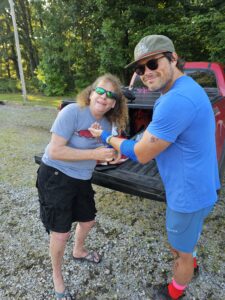 Two of the staff traveled and worked in a medical RV for the entirety of the event, while the others provided assistance at medical aid stations along the route each day.
Two of the staff traveled and worked in a medical RV for the entirety of the event, while the others provided assistance at medical aid stations along the route each day.
“It was a big undertaking, for sure, but it was a lot of fun,” said Rachel Surber, RN, clinical services manager for the UAMS Orthopaedics & Sports Medicine team in Northwest Arkansas. “The Ozark Foundation staff and coordinators were great. They were very supportive. They made sure we had all the resources we needed. They are a cool bunch of people and great to work with.”
In addition to Surber, Kelly Howk, RN, Perla Araiza, Denise White, Karen Tanner, RN, and Carrie Welch, RN, assisted at the event.
This was the first year for the Graveler, but the Ozark Foundation has about 10 other annual events that the UAMS team in Northwest Arkansas helps with, including another multiday race called Expedition Ozark that is held in March. For that race, a multidisciplinary team of medical assistants, nurses, X-ray techs, physical therapists, certified athletic trainers, schedulers, patient reps, access staff, students, residents and doctors provided 24-hour medical support for six days.
“Our relationship with the Ozark Foundation is perhaps our greatest work effort that we do outside of patient care,” said Wes Cox, M.D., section chief for UAMS Orthopaedics & Sports Medicine in Northwest Arkansas and one of the on-call doctors for the Graveler. “We have been a partner of theirs for about four years. What this group is doing — and seeks to do — in Arkansas is a statewide benefit that is so rich for all Arkansans. Also, it is a group that is a blast to be a part of.”
The Graveler started the first day with 325 riders. About 100 of those were one-day riders of the mini-Graveler. About 225 riders did the full, six-day event. The daily ride distances varied between 40-70 miles, depending on the difficulty of terrain. According to Surber, the most challenging routes were Sunday through Tuesday, due to the higher elevation levels. Hydration and heat were primarily the medical issues the team treated, she said. Ironically, one of the hottest days of the race was National Hydration Day in the U.S.
“They had a lot of issues that first day with heat-related stuff,” Surber said, “We pounded through some IV fluids that first day. Wednesday through Friday were much better. The heat tapered off a little bit, and the races started a little earlier.”
The team started with about 20 bags of IV fluid the first day. By the time Surber got there on Monday, they were already down to about five. So she made a trip back to Fayetteville to get 30 more bags.
“We ended up with about 10 left over on Friday,” Surber said. “We went through a lot of bags of IV fluids — definitely more than any other event we’ve covered. In addition to hydration issues, we had a lot of general first aid stuff. A lot of foot care, bandaging of scrapes and abrasions. We did have someone who broke their collarbone, so we had to stabilize that and get them to an urgent care ER facility.”
They also encountered an unusual medical situation that you may only find during a remote event like this.
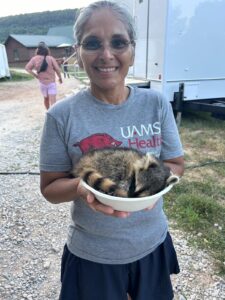 “One of the riders found a small racoon in the road,” Surber said. “It was just super-dehydrated, and it looked like it was not going to make it. So, she picked it up and put it in her little bib and road to the next station. We got in touch with one of the animal rescues in the area, and they came and got it for rehabilitation.”
“One of the riders found a small racoon in the road,” Surber said. “It was just super-dehydrated, and it looked like it was not going to make it. So, she picked it up and put it in her little bib and road to the next station. We got in touch with one of the animal rescues in the area, and they came and got it for rehabilitation.”
The medical RV would be at the starting line each day and then drive to the finish line to wait for people to come through. That’s where all the IV and rehydration stuff was going on. The team also set up two to three aid stations along each day’s route.
On some of the days, the medical team would get to the finish area before the race staff. It was because of this that White became known as the “Race Mom” because she was making sandwiches for people out of her own cooler and handing out food because the big supply truck wasn’t there yet.
Shea Brannan, M.D., a UAMS orthopaedic hand surgeon and the other on-call doctor during the race, praised Surber, White and the rest of the team for their dedication and commitment to the health and welfare of the riders.
“Dr. Cox and I provided some support, but no doubt the people who deserve the most credit are the folks who were out there on the course doing incredible work taking care of riders who were facing a lot of challenges in the heat,” Brannan said. “It’s a tremendous story, but Rachel and the medical assistance staff need to be the ones getting the accolades.”
UAMS is the state’s only health sciences university, with colleges of Medicine, Nursing, Pharmacy, Health Professions and Public Health; a graduate school; a hospital; a main campus in Little Rock; a Northwest Arkansas regional campus in Fayetteville; a statewide network of regional campuses; and eight institutes: the Winthrop P. Rockefeller Cancer Institute, Jackson T. Stephens Spine & Neurosciences Institute, Harvey & Bernice Jones Eye Institute, Psychiatric Research Institute, Donald W. Reynolds Institute on Aging, Translational Research Institute, Institute for Digital Health & Innovation and the Institute for Community Health Innovation. UAMS includes UAMS Health, a statewide health system that encompasses all of UAMS’ clinical enterprise. UAMS is the only adult Level 1 trauma center in the state. UAMS has 3,485 students, 915 medical residents and fellows, and seven dental residents. It is the state’s largest public employer with more than 11,000 employees, including 1,200 physicians who provide care to patients at UAMS, its regional campuses, Arkansas Children’s, the VA Medical Center and Baptist Health. Visit www.uams.edu or uamshealth.com. Find us on Facebook, X (formerly Twitter), YouTube or Instagram.###
